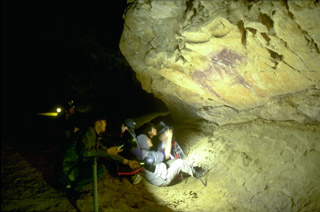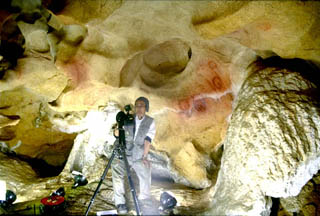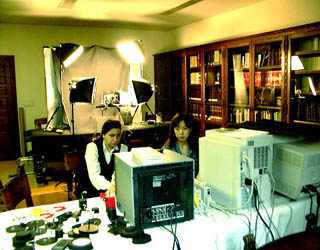|
|

PhotoVR Multimedia Database

"Paleolithic Arts in Northern Spain"

Video report on the PhotoVR shooting in Cantabrian region

"CANTABRIA ---- Paleolithic Route in Northern Spain"

Introduction

This database was developed speding about 4 years from 1998 to 2002 as a co-project organized by Texnai, Inc. and the Department of Historical Sciences at the University of Cantabria. Much of the first year was taken up seeking advice, defining objectives, organizing the fieldwork and writing the texts that accompany the photographs in the Database. These were taken by the magnificent team of photographers and multimedia experts belonging to Texnai Inc. of Tokyo, who deployed the latest techniques in virtual reproduction in prehistoric caves and museums throughout the Cantabrian Region. [ Photo above: Photo shooting in front of a wall paint "Purple Horse" in Tito Bustillo cave in Ribadaseilla, Astrius, Photographed by Roberto Cacho Toca, April 1998 ]
Originally, the database was developed by using Macintosh, but it was converted 2 years later to Windows PC to meet the demands of many other Windows users.
During our photoVR shooting in Cantabrian region, we tried to shoot as much video as possible. The DVD-VIDEO "CANTABRIA" is a video report on this digital archiving mission edited by selecting only the shooting scenaries from the several hundred hours of digital video tapes.
Many people involved in this project can been seen in this video, but thanks to the shapes of ours, it allows us to realize more about the dimension of caves and the wall paints. This is the reason why we attached this video report with the database.
 Essentially, the Database offers people interested in Paleolithic art a full photographic record, making use of virtual reality techniques in order to overcome traditional limitations. In this way, it becomes possible to understand the rock art inside the chambers of a cave, or handle a decorated object and appreciate its tiniest details. [ Photo above: Spherical panorama shooting in a small gallery surrounded by sex symbols, Tito Bustillo cave in Ribadaseilla, Astrius, Photographed by Roberto Cacho Toca, April 1998 ]
Essentially, the Database offers people interested in Paleolithic art a full photographic record, making use of virtual reality techniques in order to overcome traditional limitations. In this way, it becomes possible to understand the rock art inside the chambers of a cave, or handle a decorated object and appreciate its tiniest details. [ Photo above: Spherical panorama shooting in a small gallery surrounded by sex symbols, Tito Bustillo cave in Ribadaseilla, Astrius, Photographed by Roberto Cacho Toca, April 1998 ]
From the point of view of prehistoric cave art research, the Database provides a good opportunity to learn the latest information about Paleolithic works of art in the Cantabrian Region. This natural region had its own cultural characteristics in the Upper Paleolithic, and certain intra-regional differences. Furthermore the Database introduces an integrated approach, covering both rock art in caves and the surprising miniatures created in portable objects. It includes not only the large, internationally famous sites such as Altamira, Tito Bustillo or Ekain, but also less spectacular caves, like La Loja, Pondra and Arenaza, which we believe to be equally necessary in order to obtain a truer idea of the plural reality of the art.
The Database contains a large number of interrelated photographs, and information about decorated objects and cave paintings, about the depictions in certain caves, and about prehistoric art in the region. The twenty-two caves that it covers include several that are closed to the general public or with serious limitations in the number of visits (such as Pe–a Candamo, La Lluera, Chimeneas and Pasiega, Altamira, Pondra, Arenaza, Santimami–e and Ekain). These measures are taken in order to conserve the paintings adequately, or because the art is located in narrow passages that are not suitable for tourist visits. However, the technology employed here allows the user to understand the interior layout of the caves, and assess the works of art in their spatial and physical context, in a more complete way than is obtained from the two-dimensional view of traditional photographs. This is of vital importance, as prehistoric art was produced on surfaces that varied greatly in quality, size and position, and the Paleolithic artists showed their mastery in the way they incorporated the irregularities in the walls and ceiling into their depictions of animals and signs. In the same way, the decorated areas are quite variable in their ease of access, their capacity and the possibilities for viewing the figures at a distance.
 The photographs of mobiliary art illustrate unique objects that, at best, are normally only seen in a glass case in a museum, usually from only one side. Here it is possible to observe the techniques used in the preparation of these artifacts and their decoration, often better than with the original in our hand, as the light does not fluctuate, and our hands do not shake. We can rotate the object to examine the other side, or enlarge the photograph and see the smallest detail, such as the remains of red coloring on the ibex head from Cueva de Tito Bustillo, the tiny hairs on the ears of the hinds on the staff from El Pendo, or how the barbs were cut in the harpoons found in many Magdalenian sites. [ Photo above: Omniview shooting of mobil arts by using Texnai AutoQTVR mini at the archeological museum on Bilbao, Viscaya, Photographed by Hiroaki Seki, April 1998 ]
The photographs of mobiliary art illustrate unique objects that, at best, are normally only seen in a glass case in a museum, usually from only one side. Here it is possible to observe the techniques used in the preparation of these artifacts and their decoration, often better than with the original in our hand, as the light does not fluctuate, and our hands do not shake. We can rotate the object to examine the other side, or enlarge the photograph and see the smallest detail, such as the remains of red coloring on the ibex head from Cueva de Tito Bustillo, the tiny hairs on the ears of the hinds on the staff from El Pendo, or how the barbs were cut in the harpoons found in many Magdalenian sites. [ Photo above: Omniview shooting of mobil arts by using Texnai AutoQTVR mini at the archeological museum on Bilbao, Viscaya, Photographed by Hiroaki Seki, April 1998 ]
Finally, the Database includes a large number of scenic views of the region, from the Pyrenees in the north of Navarra to the Nal—n valley in the center of Asturias. These photographs are interesting to give an idea of the landscape in which the groups of Paleolithic hunters lived. In some cases (such as the circular panoramas from the tops of Pe–a de Candamo, Ardines hill, Monte Castillo and Ekain hill) they are quite spectacular views and rarely known even by specialists in Paleolithic archeology. They make it possible to visualize the territory around the site and the strategic value of the locations chosen by Paleolithic hunters.
The team at the Department of Historical Sciences at the University of Cantabria, in close and friendly collaboration with the photographers and software experts of Texnai, have worked together in order to offer a complete version of our Paleolithic artistic heritage, in an up-to-date product intended for the general public at a medium to high level. However, we believe that this Database will also be of interest to researchers in prehistoric art, given the possibilities it provides for the study of manufacturing and decoration techniques in bone and antler, of the composition of cave art panels, and the discovery of new figures, among other aspects. We aim, therefore, to contribute to a wider diffusion of information about this early, spectacular, artistic development, and at the same time, to its more efficient conservation. We also hope to arouse in the user the same emotion that we have felt while working in the caves in the Cantabrian region. An emotion that is linked to the vividness and expression of many of the figures of animals, and also, despite the great cultural and chronological distance separating us, to the recognition of the pulse of humanity beating in all these paintings created by our ancestors at the end of the Ice Age.
Prof. Dr. C. González Sainz, Department of Historical Sciences, University of Cantabria
Takeo Fukazawa, Chief Producer, Texnai, Inc.
Texnai, Inc.
2-1, Udagawa-cho, Shibuya-ku, Tokyo, Japan. Tel:03-3464-6927 Fax:03-3476-2372
e-mail: paleoarts@texnai.co.jp
Copyright:Texnai, Inc.
|
|

